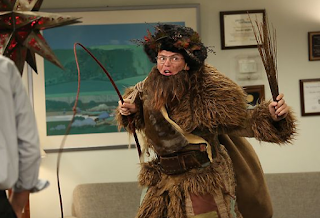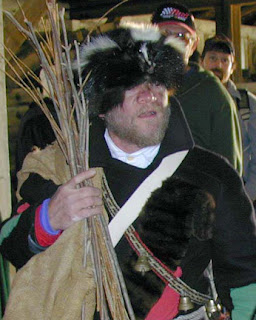 |
| Guten Abend! |
As a note, it is just Krampus; there is no "the" before it, as Krampus is his name. It's related to the old Germanic word for claw, which gives you some idea as to his nature! I should also note that in many regions of Europe, Santa Claus and St. Nicholas are two distinct beings and the names are not interchangable as they are in the United States. In Germany therefore you have both Sankt Nikolaus and Der Weinacthsmann (literally "the Christmas Man") who have different jobs and responsibilities. Krampus is sometimes represented today as a companion of the latter, but usually and traditionally he is solely associated with the religious figure of St. Nicholas and his associated holiday traditions.
The Mythology
 |
| Mwahahahah.... I mean, Ho Ho Ho! |
So in much of Europe, St. Nicholas has specific, named helpers. It's from these helpers that we probably get the American idea of Santa's generic elves. In every region these companions are different; in some regions he has only one, in others he has many, but they tend to fall into a few archetypes. The two more common are the Christmas helper, who acts as a benign figure helping the Saint, and the "anti-Saint", usually a figure who punishes or scares bad children. These figures act as the negative reinforcement to St. Nicholas' positive reinforcement, and perform a role that you might associate with the boogeyman in the English speaking world.
Krampus is most definitely the latter, and is by far the most fearsome. Krampus is half demon, half goat, and resembles the Greek Satyr with a long tongue, covered in chains, and wielding a bundle of branches. The mythological origins of Krampus vary, but I'll share the one I heard most often while visiting the Alpine regions of Germany and Austria as a kid. The story goes that one day while travelling, St. Nicholas encountered a ferocious demon, the son of the Norse Pagan god Hel. The beast challenged the Saint to a spiritual battle, and each agreed that they would serve the other if they lost. Nicholas defeated the demon handily, and instead of simply banishing him, decided to put his wicked skills to use for the greater good. He bound the demon, Krampus, in chains, to serve him for all time. Other origins claim that the two are simply opposite sides of the same coin, or that Krampus follows St. Nick willingly.
On December 5, the eve of St. Nicholas' feast day, the Saint and Krampus appear. This night is often referred to as Krampusnacht, or the Night of Krampus. Usually, the duo have been "at large" since the feast of St. Martin (Martinstag in German, on November 11), but appear to begin their duties on the night of the 5th. Children are visited by the Saint, who gives them small toys, fruit and candy if they have been good, or leaves gifts in their shoes (left by a door or window) after they fall asleep. If the children have been bad though, they do all they can on this day to reform their ways in hopes of avoiding the notice of Krampus.
 |
| You REALLY want to avoid his notice... |
The Traditions
In addition to being used as a threat by flustered parents, there are more tangible Krampus-related traditions. The most famous is the Krampuslauf, or Krampus Run, a type of Krampus-themed parade and gathering. The young men in a village or neighborhood will don handmade Krampus costumes, carefully built during the preceding year, and march or run through the village rattling their chains and being frightening. They can be bought off by offering them schnapps, and by the end of these events the young men are normally well and truly drunk and are chasing their sweethearts and crushes instead of the local children.
During the holidays a person may visit homes, schools or businesses dressed as St. Nicholas, and he might in turn be accompanied by a Krampus. The Saint will hand out candies or fruit (oranges are traditional), while the Krampus will make fearsome noises and hand coal or Ruten to parents with a wink. These events are most common on the 5th of December, but may occur at any time between the feast of St. Martin (November 11) and Epiphany in January, a period broadly defined as the Christmas season in southern Germany and Austria.
 |
| Vintage Krampus |
These gatherings were banned during the Nazi era, when the drunken parties that devolved from the Krampuslauf were seen as a threat to public morals. In Germany, Austria, and surrounding areas Krampus' popularity has waxed and wained over the years. When I was a kid it had become more of a rural tradition, but in recent years Krampus has begun to make a comeback with his growing recognition in popular culture. With that said, Krampus has also become controversial in German-speaking countries in recent years, with some questioning the appropriateness of telling such fearsome stories to young children. However, most people agree that Krampus and other "evil" companions of St. Nicholas serve an important purpose as tools for punishment and discipline.
 |
| Traditional Krampus Card. The bottom "Gruss vom Krampus" means "Greetings from Krampus" and is the most commonly featured phrase on these cards. |
 |
| Stupid Sexy Krampus! |
The Origins
So how did all of this come about? Nobody is really sure to be quite honest, but most scholars agree that Krampus grew out of traditions from before the coming of Christianity to Germany. Horned animal gods were common motifs in in mytholoy and religion in ancient Germany, and the creation of the Krampus myth may have served to demonstrate the power of the Church over these older gods or devils. Young men dressing as demons or beasts to cause mischief or celebrate festivals became popular in Europe during the high Middle Ages, and the current Krampus traditions probably date to around that time.
 |
| Norse-Germanic Horned God featured on a cauldron found in Northern Jutland. |
Other Christmas Companions
As noted above, St. Nicholas has lots of companions which vary by region. Here's a few of the more notable ones.
Belsnickel: This guy is popular in Southern and Western Germany, and was featured as a joke in the American version of "The Office". This is the companion that was most common in the region of Germany where I grew up, and I only became familiar with Krampus after our family would travel to Austria for Christmas with a family friend. He's a fearsome figure, but much more friendly than Krampus, and I often compare him to a mix of Hagrid from Harry Potter and Krampus. He's a large bearded figure who may give candy or sweets, or coal or switches, depending on how good a child was, and usually arrives separately from St. Nick. Before Krampus became popular in the US, he was probably the most well-known companion, with certain communities in Canada and the American midwest (especially the Pennsylvania Dutch) retaining the tradition.
 |
| Dwight Schrute on The Office playing Belsnickel. He's shockingly accurate! |
Zwarte Piet: Zwarte Piet is a sort of generic servant to St Nicholas popular in the Netherlands and Belgium. In recent years the character has became a huge center of controversy, because he is normally portrayed by a white European wearing a renaissance-style costume featuring blackface makeup. The reason for this is varied; some say Zwarte Piet is shown this way to represent to soot he's covered in from going down a chimney, while others say that he first appeared as a Moor, a medieval word used to describe black North Africans. I won't get into the controversy here, but due to the connotations of Blackface in the United States (connotations not necessarily associated with Blackface in Europe) the figure has never become as widely popular as other Companions.
 |
| Seriously, I'm not touching this one |
Knecht Ruprecht: Usually portrayed as an elderly monk, shepherd, or farmer, Knecht Ruprecht is a generic manservant to St. Nick. He's common in the Black Forest Region and sometimes appears alongside Belsnickel whom he somewhat resembles. He will ask children if they know their prayers or if they will sing him a song. If they answer positively they receive fruit and nuts, and if they answer negatively or refuse to sing may be punished.
Perchta: This witch isn't necessarily a companion of the Saint, but she often appears at Christmas and women wanting to take part in Krampuslauf will dress as this figure instead. In Germanic peganism Perchta was a goddess, but since the coming of Christianity is usually portrayed as a witch or nature spirit. At midwinter she was said to roam the countryside, overseeing the spinning and sewing of young women. If she encountered good and kind children they would find a coin in their shoe or under their pillow the next day; if she encountered lazy or naughty ones she would slit their bellies open in their sleep. Yeah. And you thought Krampus was terrifying...
 |
| Some Percthen costumes resemble Krampus costumes, but it varies by region |
 |
| Like Krampus, Schmutzli also carries Ruten. |
Any questions about Krampus or any of the other companions? Let me know, and behave or Krampus will find you!




No comments:
Post a Comment